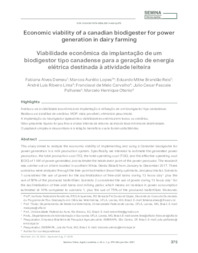Economic viability of a canadian biodigester for power generation in dairy farming.
Economic viability of a canadian biodigester for power generation in dairy farming.
Author(s): DEMEU, F. A.; LOPES, M. A.; REIS, E. M. B.; LIMA, A. L. R.; CARVALHO, F. DE M.; PALHARES, J. C. P.; OTENIO, M. H.
Summary: This study aimed to analyze the economic viability of implementing and using a Canadian biodigester for power generation in a milk production system. Specifically, we intended to estimate the generated power production, the total production cost (TC), the total operating cost (TOC), and the effective operating cost (EOC) of 1 kW of power generated, and estimate the break-even point of the power produced. The research was carried out on a farm located in southern Minas Gerais (Brazil) from January to December 2017. Three scenarios were analyzed through the tree-point estimation (most likely, optimistic, and pessimistic). Scenario 1 considered the use of power for the acclimatization of free-stall barns during 13 hours day-1 plus the use of 50% of the produced biofertilizer. Scenario 2 considered the use of power during 13 hours day-1 for the acclimatization of free-stall barns and milking parlor, which means an increase in power consumption estimated at 10% compared to scenario 1, plus the use of 75% of the produced biofertilizer. Moreover, scenario 3 considered the use of power for the acclimatization of free-stall barns during 6.5 hours day-1 plus 25% of the produced biofertilizer. All scenarios considered the amount charged per kWh by the Companhia Energética de Minas Gerais (CEMIG). Monte Carlo simulations were carried out with minimum acceptable rates of return ranging from zero to 50%. Power generation was economically viable in all scenarios, with positive net present value (NPV), internal rates of return above the minimum acceptable rate of return, simple and discounted payback below the 10-year horizon, and satisfactory benefit-cost ratios. The EOC values of 1 kWh of power were estimated at R$ 0.1990, R$ 0.1791, and R$ 0.3308 for scenarios 1, 2, and 3, respectively, whereas the mean total cost (TC) was R$ 0.5618 (±0.21) considering all scenarios, above the purchase values at CEMIG, which would be R$ 0.50. The TC value was R$ 99,804.42 for scenarios 1 and 2, and R$ 92,424.09 for scenario 3, with a minimum acceptable rate of return of 8.50, while the TOC values were R$ 69,486.62 in scenarios 1 and 2, and R$ 62,229.66 in scenario 3. The amount of power generated in all scenarios was higher than the break-even point. All Monte Carlo simulation models showed positive NPV values, indicating that there is a high probability of being above expectations.
Publication year: 2021
Types of publication: Journal article
Observation
Some of Embrapa's publications are published as ePub files. To read them, use or download one of the following free software options to your computer or mobile device. Android: Google Play Books; IOS: iBooks; Windows and Linux: Calibre.
Access other publications
Access the Agricultural Research Database (BDPA) to consult Embrapa's full library collection and records.
Visit Embrapa Bookstore to purchase books and other publications sold by Embrapa.

